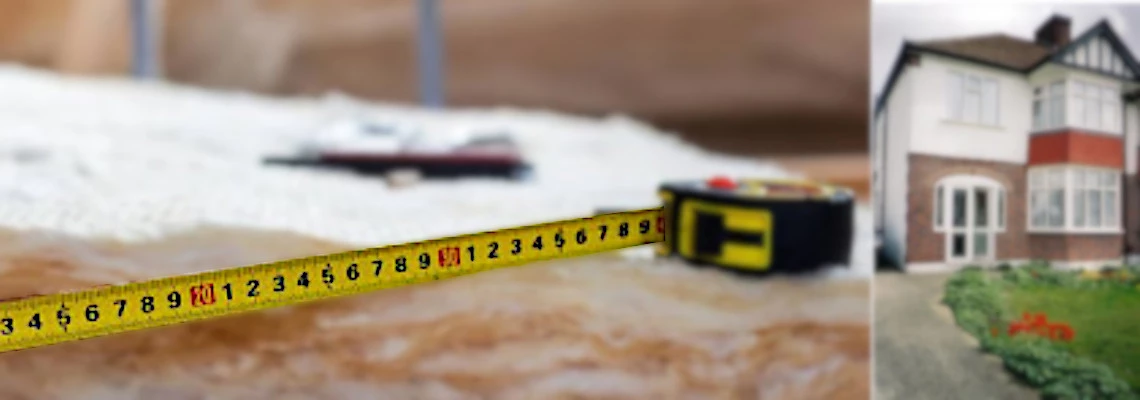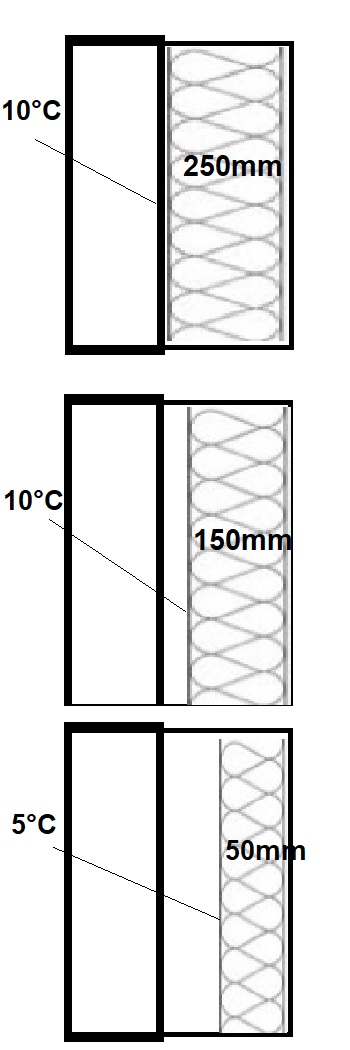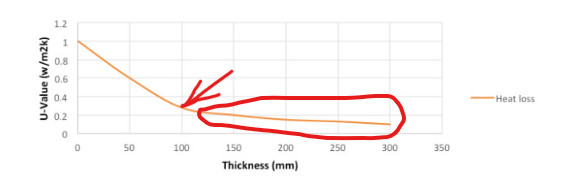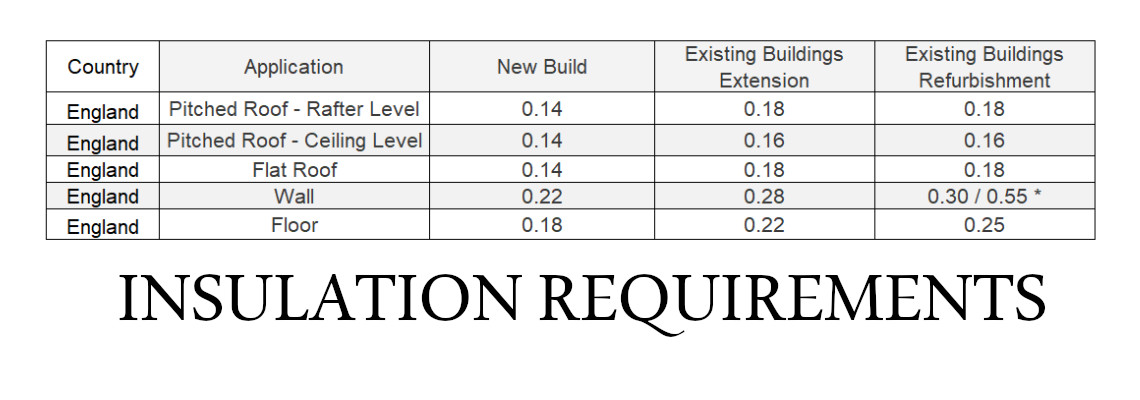
SELECTING THE IDEAL INSULATION THICKNESS*
One of the elements contributing to maintaining a favourable indoor climate in a building is the thermal insulation of walls, roofs, and floors. Properly matched insulation thickness ensures energy efficiency.
It turns out that selecting the right type of insulation is one thing, and choosing the appropriate thickness is another. Interestingly, in our store, as many as 7 out of 20 customers inquire about the thickness of insulation they should use. What's even more intriguing is that 6 out of 10 opt to purchase the thinnest available insulation. By reading this article, you will find out why the majority of homeowners choose this method, identify the ideal insulation thickness for your needs, all while keeping your budget in mind. We'll begin with the roof, as it's where the most heat tends to escape from your home, followed by discussions about walls and floors.
WHY IS INSULATION THICKNESS SO CRUCIAL?
If we were to define insulation thickness in the simplest terms, it's the amount of material required to achieve a specified U-value. On the other hand, the U-value is like a mathematical puzzle that combines the thermal resistances of all the layers forming a building element into a single, revealing number.
The fundamental aspect guiding the selection of insulation thickness should be the Building Regulations, and buildings and their thermal insulation should align with them.
Failing to comply with Building Regulations not only opens you up to potential issues during building inspections but also, in a sense, misleads your own best interests.
For instance, if the guidelines stipulate achieving a U-value of X, and you opt for thinner (and cheaper) insulation, not only will you fail to reach the intended U-value, but you'll eventually have to purchase insulation once again, essentially paying double for its installation.
When selecting the thickness of thermal insulation, the primary factors to consider are the existing building envelope and, of course, the chosen insulation material.
The key goal is to achieve the highest possible thermal resistance (R-value).
WHAT THICKNESS INSULATION SHOULD I USE? OPTIMAL INSULATION THICKNESS IN CONSTRUCTION
Selecting the wrong insulation thickness can lead to adverse consequences. Let's say you decide to install insulation with a thickness twice as much as required. It might seem like it would bring even greater savings. However, that's far from the truth!
The thickness of insulation and its R-value is effective up to a certain point, beyond which further investment in thicker insulation material becomes pointless. For example, if a 150mm thickness of particular insulation provides complete cold air blockage, its thicker version will offer the same cold air blockage.
50mm = temperature on the inner side of the insulation at 5°C
150mm = temperature on the inner side of the insulation at 10°C
250mm = temperature on the inner side of the insulation at 10°C
 It's also important to remember that once you exceed the optimal thickness of insulation, adding more layers will not contribute to additional savings and will only constitute unnecessary expenditure.
It's also important to remember that once you exceed the optimal thickness of insulation, adding more layers will not contribute to additional savings and will only constitute unnecessary expenditure.
Let's consider the scenario of purchasing insulation that is too thin. It turns out that buying thinner insulation makes more sense than buying insulation that is too thick.
Why is that? There are two main reasons.
Firstly, assuming that you'll be installing it yourself, with installation costs at zero, it makes more sense to purchase a much cheaper and thinner insulation and measure its effectiveness.
If 50mm of insulation provides an inner temperature of around 5°C, then it can be confidently stated that adding another 50mm of insulation would have a more significant impact.
Secondly, by installing two layers of insulation, you eliminate the thermal bridges created by the first layer. By overlapping them, you completely block the flow of cold air.
So, two layers of 50mm insulation will give us a result
2 x 50mm = temperature on the inner side of the insulation at 10°C
The remaining question is whether two layers of 50mm insulation will be cheaper than one layer of 100mm. Well, it's not, for simple manufacturing reasons.
Producing a single layer of insulation takes half as much time.
Therefore, two layers of insulation should never cost less than one layer individually. When you buy two layers of insulation, you're paying about 20-30% more than buying one layer.
Nevertheless, taking into account the effects that layering insulation in your home will bring, it makes sense, especially since you'll never overpay for unnecessary insulation thickness.
WHAT THICKNESS OF INSULATION IS BEST?
Setting aside Building Regulations and focusing solely on mathematics, one can assert that the optimal insulation thickness is 100mm. Calculating the U-value each time for a given type of insulation and varying its thickness, it becomes evident that 100mm thickness turns out to be the best choice. It's the insulation thickness beyond which the energy savings gained from using thicker insulation are not significant, and it simply doesn't make much sense in practical terms.

By employing calculation methods within a range of insulation thicknesses from 50mm to 350mm, it becomes clear that heat loss levels off, approaching a nearly horizontal line, signifying that heat losses at this point are minimal.
In summary, considering heat losses, the most substantial energy savings are achieved within the initial 100mm of insulation.
BUILDING REGS vs INSULATION THICKNESS
In the realm of insulation, homeowners must adhere to specific Building Regulations designed to curtail heat loss, reduce energy consumption, and establish a comfortable living atmosphere.
Adhering to insulation requirements not only leads to cost savings on energy bills and reduced carbon emissions but also enhances the overall comfort and well-being of occupants.
In terms of insulation, Building Regulations specify a mandatory U-value that must be met. This U-value varies depending on the location of your building and the specific application area, be it the floor, wall, or roof.
Essentially, the U-value quantifies how quickly heat is transferred through a building element, with lower U-values indicating better insulation performance. These regulations establish maximum allowable U-values for different parts of a property, ensuring compliance with required standards.

PIR boards are the most commonly used insulation material in the UK. Therefore, we will focus on them as an example.
The PIR U-value table serves as a valuable reference for selecting suitable insulation thicknesses and understanding the thermal effectiveness of PIR insulation.

As demonstrated in the table above, achieving a U-value of 0.25 for floors in the UK necessitates thicknesses of 90mm, 100mm, 110mm, or 120mm.
For walls aiming for a U-value of 0.17, appropriate thicknesses range from 125mm to 200mm.
Lastly, to attain a U-value of 0.16 for roofs, recommended thicknesses are typically in the range of 140mm to 200mm.
Typically, a recommended thickness for PIR insulation in floors is around 100mm to achieve the desired U-value of 0.25 W/m2K. Similarly, for walls, a thickness of approximately 125mm is recommended to reach the target U-value of 0.17 W/m2K.
UK BUILDING REGS vs ROOF INSULATION THICKNESS
In the case of roofs, a typical recommended thickness is between 140mm to 200mm to attain the desired U-value of 0.16 W/m2K.
These requirements are quite demanding, mainly because of the substantial heat loss that occurs through the upper parts of buildings.
To comply with these standards, you would need a minimum of 150mm of PIR insulation (with an R-value of 6.82m2K/W) as the initial layer. On the other hand, Phenolic foam board could satisfy the same standards with a thinner layer of 140mm (and an R-value of 7.35m2K/W).
If you opt for mineral wool, you would need to use two layers, each with a thickness of 200mm (and an R-value of 4.54m2K/W) to meet the requirements.
FLAT ROOF INSULATION THICKNESS | MINIMUM INSULATION THICKNESS FOR WARM FLAT ROOF
The thermal conductivity of 6mm WBP Plywood stands at 0.13 W/mK (Lambda value). Considering this thermal conductivity, its R-value can be calculated as 0.06 / 0.13 = 0.46 m2K/W.
Now, let's consider, for instance, 140mm Unilin PIR insulation with an R-value of 6.36m2K/W. We can easily calculate the required thickness of Plydeck for flat roof insulation to meet Building Regulations:
140mm Unilin PIR (6.36m2K/W) + 6mm Plywood (0.46 m2K/W) = 6.82m2K/W
Now, calculating the U-value:
U = 1 / [ R = (R1 + R2 + …) ]
6.36 + 0.46 = 6.82m2K/W
1 / 6.82m2K/W = 0.146W/m2K
From this mathematical analysis, it is evident that to achieve a U-value of 0.16 W/m2K for a flat roof, you would need to use Plydeck with a thickness of 146mm, which provides a U-value below this threshold (0.146W/m2K).
For more information on U-values, you can refer to our previous discussion here.
The U-value, which is a measure of the thermal performance of a building element, must be below a certain threshold.
Therefore, the mathematical calculations indicate that to achieve a U-value of 0.16 W/m2K for flat roofs, it would be necessary to use Plydeck with a total thickness of 146mm. Utilising such thickness enables compliance with the requirements mandated by the current Building Regulations in the UK.
PITCHED ROOF INSULATION THICKNESS
In the context of a pitched roof, the prevailing Building Regulations stipulate a minimum U-value of 0.18 W/m2K for a warm roof, where insulation is positioned above and between the rafters, and 0.13 W/m2K for a cold roof, where insulation is placed between and beneath the rafters.
In accordance with UK Building Regulations, there is a prescribed minimum insulation thickness of 270mm for both new and existing pitched roofs.
The recommended thickness of insulation between rafters can vary depending on the type of insulation material used. For instance, 100mm of fibreglass insulation typically possesses an R-value of 2.25m2K/W. Consequently, an insulation thickness of 270mm would result in an R-value of approximately 6.09m2K/W.
In contrast, PIR insulation tends to offer a higher R-value per inch of thickness compared to other insulation types, boasting an R-value of approximately 4.50m2K/W per 100mm. This means that a thinner layer of PIR insulation can yield the same level of thermal performance as a thicker layer of other insulation materials. For example, a 100mm thickness of PIR insulation would provide thermal resistance equivalent to that of a 170mm layer of mineral wool insulation.
A thickness of 130mm of PIR Unilin insulation (with a U-value of 0.169) can be applied to attain a U-value of 0.18 W/m2K for a warm roof, whereas a thickness of 165mm of Unilin PIR insulation (with a U-value of 0.13) can be utilised to meet the requirement of 0.13 W/m2K for a cold roof.
Additionally, a 60mm layer of phenolic insulation can deliver equivalent thermal performance to 150mm of mineral wool insulation. When dealing with shallow or space-constrained rafters, phenolic insulation can be an attractive choice due to its ability to offer a high level of thermal performance with a thinner layer of insulation.
CEILING INSULATION THICKNESS
Most homes in the UK have insulation installed above the upper floor ceiling, creating a ventilated space under the roof. If there's a livable area within this space, it's crucial to insulate between the living area and the roof covering.
For instance, to achieve a U-value of 0.16 W/m²K for a flat ceiling, you'll need a minimum of 170mm thick mineral fibre insulation placed between the ceiling joists, along with an additional 100mm thick layer covering the joists.
For a U-value of 0.18 W/m²K on a pitched ceiling, you should consider using rigid PIR foam insulation like Unilin or Celotex, with at least 140mm thickness between the rafters and an extra 15mm layer beneath the rafters.
UK BUILDING REGS WALLS vs INSULATION THICKNESS
Meeting the mandated UK Building Regulations with a U-value of 0.30 for wall insulation demands careful material selection. Insulation materials must have a thickness exceeding 75mm or possess an R-value ranging from 3.30m2K/W to 4.54m2K/W.
WALLS - Minimum Thickness for Mineral Woll
For example, to achieve this with mineral wool, a thickness of 200mm is necessary, providing an R-value of 4.54m2K/W. It's important to note that mineral wool is comparatively less efficient than PIR rigid insulation boards, requiring a minimum thickness of 120mm to attain the desired insulation level.
Products:
Knauf Earthwool Loft Insulation Roll
WALLS - Minimum Thickness for PIR Rigid Foam Insulation
PIR insulation boards should have a minimum thickness of 65mm, equivalent to an R-value of 3.41m2K/W.
Products:
WALLS - Minimum Thickness for Polystyrene
Conversely, if you opt for polystyrene insulation, a thickness of 110mm is required, resulting in an R-value of 3.66m2K/W.
Products:
Grey EPS Polystyrene Insulation Board
WALLS - Minimum Thickness for Phenolic Boards
For maximum efficiency, consider using phenolic foam board, which achieves optimal wall insulation with a minimal thickness of just 60mm, boasting an R-value of 3.30m2K/W.
Products:
UK BUILDING REGS vs FLOOR INSULATION THICKNESS
Building regulations stipulate specific thermal performance standards for floors, as assessed by U-values. These U-values determine how effectively heat can transfer through the floor, thereby influencing the required level of insulation.
For example, in order to meet the recommended U-value of 0.25 W/m2K or lower, various insulation materials and thicknesses come into play.
FLOOR - Minimum Thickness for Phenolic Boards
High-performance phenolic foam insulation would necessitate a minimum of 70mm (equivalent to an R-value of 4.15m2K/W).
Products:
SR/UF Safe-R Phenolic Floor Insulation Board Xtratherm
FLOOR - Minimum Thickness for Mineral Wool
Alternatively, rock wool insulation would require a thickness of 150mm (with an R-value of 4.40m2K/W) to achieve the desired U-value.
Products:
Earthwool Loft Insulation Roll 44 Combi Cut
FLOOR - Minimum Thickness for Polystyrene
Extruded polystyrene (XPS) insulation should have a minimum thickness of 140mm (R-value 4m2K/W). On the other hand, to reach the specified U-value of 0.25, EPS70 expanded polystyrene would need to be at least 150mm thick (with an R-value of 4.40m2K/W)
Products:
Grey EPS Polystyrene Insulation Board
CONCLUSION
In conclusion, mathematics is a reliable guide that informs your insulation decisions. In fact, in the realm of insulation, mathematics plays a pivotal role in guiding us toward the right decisions. It all begins with understanding the required U-value, which dictates how heat behaves within your structure. Once you've identified this value, selecting the insulation material becomes the next crucial step.
Knowing the material type allows you to choose perfect R-value, which, in turn, helps you determine the U-value. If the U-value exceeds the standards set by Building Regulations, the solution is clear: increase the insulation thickness until you attain the desired outcome.
Related articles:
BUILDING REGULATION PART L CHANGES
FOIL INSULATION: TO GAP OR NOT TO GAP? THAT IS THE QUESTION!
SUSTAINABLE AND AFFORDABLE: KINGSPAN ALTERNATIVES AND EQUIVALENTS THAT WON'T BREAK THE BANK
INSULATION COST COMPARISON: EPS vs PIR vs MINERAL WOOL
THE BENEFITS OF THERMAL INSULATION: ENERGY SAVINGS, COMFORT, AND PROTECTION
BIBLIOGRAPHY:
1. Buildingcontrol.bathnes.gov.uk, Local Authority Building Control, ‘Thermal Insulation’, accessed , October 4, 2023
2.Energysavingtrust.org.uk, ‘Internal wall Insulation’, accessed , October 4, 2023
*All the information provided in the content published on Insulationgo blog is for informational and educational purposes only. Insulationgo LTD makes every effort to ensure the accuracy and timeliness of the content, but we do not assume any responsibility for any errors or omissions.
The information presented on this blog should not be considered as professional advice or a substitute for consulting relevant experts. Before making any purchase decisions or taking action based on the information presented here, it is strongly recommended to contact the product manufacturer directly to verify the details and ensure its suitability for your specific needs.
Any descriptions, drawings, photographs, data, proportions, weights, measured values etc. given herein may change without prior notice and do not constitute the agreed contractual quality of the products. It is the responsibility of the recipient of all products to ensure that any proprietary rights and existing laws and legislation are observed.
By using this blog, you acknowledge and agree that Insulationgo LTD shall not be held liable for any damages, losses, or inconveniences arising from the use or reliance on the information provided herein. This limitation of liability applies to all users of the blog, including but not limited to visitors, readers, and subscribers.










































































































